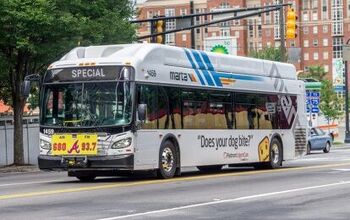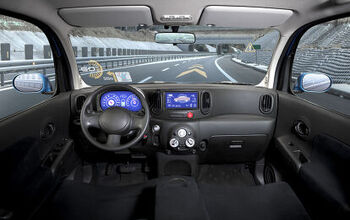Time To Buy? New Vehicle Inventories And Incentives Are Up

After several years of swelling vehicle prices and tragically lean inventories, the market has reached a point where dealer lots are getting full and consumers are becoming disinclined to go into quite so much debt in order to purchase a new automobile. But does this mean you should head out to the showroom to purchase that new model you’ve been considering, or will there be even better deals to be had in the future?
Everything is relative in the world of car buying. According to the latest from the Cox-owned vAuto Live Market View, the U.S. market is sitting on 77 days of new product as of September 5th. While that’s significantly higher than what was witnessed this time last year, it’s actually down slightly from the first half of 2024. But we’re still not on pace to match the roughly 100-day averages witnessed throughout 2019.
Cox Automotive framed the situation as inventories having stabilized, likewise noting that past reporting of its down data sets had been made volatile due to “an industry-wide disruption caused by a cyber breach at a widely used dealer management system (DMS) supplier.” But it likewise suggested inventories had grown due to the normal influx of models from the 2025 model year, noting that they now make up roughly 25 percent of lot volumes.
Average transaction prices (ATP) have been falling, albeit minimally. The average vehicle is still listing just above $46,800 and ATPs were $47,870 ( in August), which represents a decline barely worth mentioning. ATPs were hovering around $38,350 in 2019 — highlighting just how much valuations have ballooned in recent years.
However, incentive spending was also much higher five years ago and dealers were far more willing to let go of vehicles below MSRP. Despite paying below sticker being the norm everything but the hottest models for decades, dealers have been much less willing to allow that to happen lately. Buyers have likewise been more willing to spend by entering into more debt, which we see represented monthly payments.
In 2019, the average monthly payment on a new automobile was $566, a 3.4-percent increase from the previous year. As of September of 2024, the average monthly payment on a new vehicle is a whopping $734, with used vehicles being closer to $520 a month. No matter how you slice it, that’s a staggering increase in a relatively short period of time.
Incentive spending is the silver lining here. According to Cox, the average new-vehicle incentive package was 7.2 percent of ATP ($3,383) last month, up from 7 percent in July and higher than one year ago when incentives were just 4.8 percent of ATP.
With the above in mind, it may seem like now is the time to purchase a new vehicle — especially if you’ve been holding onto one to wait for this exact scenario to play out. However, something tells me that many would-be buyers are still in a situation where the budget is too tight to rationalize a new vehicle purchase. If so, that would mean automakers and dealers alike are likely to continue sweetening the pot in an effort to draw in customers.
Any deals you may find will hinge heavily on which brands and models you’re looking at. Consumers are pivoting toward versatile vehicles assumed to offer good value for money and long-term reliability. This has left brands like Lexus, Toyota, Honda, and Subaru with far less product inventory than their rivals. Toyota’s inventory is estimated to be around 20 days, far less than the 77-day average for this month.
While you still might be able to sort out a relative bargain with the above brands, it probably won’t be on popular models like the Honda CR-V or Toyota RAV4. Conversely, brands like Dodge, Volvo, Jeep, Cadillac, Chrysler, Ford, Genesis, Mercedes-Benz, and Mitsubishi all have inventories above 100 days. Odds are good those dealerships would be more willing to offer juicy discounts on models they’d like to see sold to make room for new inventory.
However, some of the brands that aren’t resonating with the public have been chided for assumed lapses in dependability and product lineups that just aren’t resonating with the average American. There are certainly exceptions on both ends of the spectrum. But Americans seem to be focused on nameplates offering models that won’t break their bank over a lifetime of ownership and a handful of luxury brands that offer novel vehicles or products that at least stress the tenants of the given brand’s credo (Porsche and Lexus for example).
The bottom line is that consumer trends are showing that U.S. car buyers are tightening their belts, with a growing focus on practicality and affordability. Models failing to deliver on either (especially within their respective segments) are bound to struggle. The Dodge Hornet springs to mind here. While quite peppy and not half-bad to drive, the model down on cargo space and was originally priced a tad higher than its rivals. Stellantis brands have also been broadly criticized for diminishing quality control of late and that combination has left the United States with a massive oversupply of Hornets.
It's bad news for the company. But perhaps good news for anyone interested in owning a small crossover with some personality, since Dodge dealerships have been letting them go for $10,000 below sticker.
Market sentiment surveys have likewise suggested that industry players don’t have a rosy outlook in the long term. Dealers certainly seem to think that they’re entering into a period of economic uncertainty and automakers are similarly concerned that there could be a shift away from pro-EV regulations depending on how U.S. elections play out. Many car lots remain overloaded with models that would be considered relatively expensive prior to the 2020s and the buying public has less discretionary income due to economic inflation.
You could buy now and have a decent shot of spending less than you would have last year. However, there are plenty of reasons to assume discounts could grow fatter in the near future and manufacturers will do whatever they can to adjust their lineups to cater to the present market. The former is great news for consumers while the latter could go either way. Automakers may begin producing stripped down models boasting lower MSRPs that stress the fundamentals. But they could also flood the market with cheap garbage in the hopes of maintaining strong margins. Regardless, that item is something that will be determined over a period of years — not months — whereas incentive spending will impact plenty of models that are currently available.
[Images: Gretchen Gunda Enger/Shutterstock; Honda; Dodge]
Become a TTAC insider. Get the latest news, features, TTAC takes, and everything else that gets to the truth about cars first by subscribing to our newsletter.

Consumer advocate tracking industry trends and regulations. Before joining TTAC, Matt spent a decade working for marketing and research firms based in NYC. Clients included several of the world’s largest automakers, global tire brands, and aftermarket part suppliers. Dissatisfied, he pivoted to writing about cars. Since then, he has become an ardent supporter of the right-to-repair movement, been interviewed about the automotive sector by national broadcasts, participated in a few amateur rallying events, and driven more rental cars than anyone ever should. Handy with a wrench, Matt grew up surrounded by Detroit auto workers and learned to drive by twelve. A contrarian, Matt claims to prefer understeer and motorcycles.
More by Matt Posky
Latest Car Reviews
Read moreLatest Product Reviews
Read moreRecent Comments
- EBFlex Garbage but for less!
- FreedMike I actually had a deal in place for a PHEV - a Mazda CX-90 - but it turned out to be too big to fit comfortably in my garage, thus making too difficult to charge, so I passed. But from that, I learned the Truth About PHEVs - they're a VERY niche product, and probably always be, because their use case is rather nebulous. Yes, you can run on EV power for 25-30 miles, plug it in at home on a slow charger, and the next day, you're ready to go again. Great in theory, but in practice, a) you still need a home charger, b) you paid a LOT more for the car than you would have for a standard hybrid, and c) you discover the nasty secret of PHEVs, which is that when they're on battery power, they're absolute pigs to drive. Meanwhile, to maintain its' piglike battery-only performance, it still needs to be charged, so you're running into all the (overstated) challenges that BEV owners have, with none of the performance that BEV owners like. To quote King George in "Hamilton": " Awesome. Wow." In the Mazda's case, the PHEV tech was used as a performance enhancer - which worked VERY nicely - but it's the only performance-oriented PHEV out there that doesn't have a Mercedes-level pricetag. So who's the ideal owner here? Far as I can tell, it's someone who doesn't mind doing his 25 mile daily commute in a car that's slow as f*ck, but also wants to take the car on long road trips that would be inconvenient in a BEV. Meanwhile, the MPG Uber Alles buyers are VERY cost conscious - thus the MPG Uber Alles thing - and won't be enthusiastic about spending thousands more to get similar mileage to a standard hybrid. That's why the Volt failed. The tech is great for a narrow slice of buyers, but I think the real star of the PHEV revival show is the same tax credits that many BEVs get.
- RHD The speed limit was raised from 62.1 MPH to 68.3 MPH. It's a slight difference which will, more than anything, lower the fines for the guy caught going 140 KPH.
- Msquare The argument for unlimited autobahns has historically been that lane discipline is a life-or-death thing instead of a suggestion. That and marketing cars designed for autobahn speeds gives German automakers an advantage even in places where you can't hope to reach such speeds. Not just because of enforcement, but because of road conditions. An old Honda commercial voiced by Burgess Meredith had an Accord going 110 mph. Burgess said, "At 110 miles per hour, we have found the Accord to be quiet and comfortable. At half that speed, you may find it to be twice as quiet and comfortable." That has sold Mercedes, BMW's and even Volkswagens for decades. The Green Party has been pushing for decades for a 100 km/h blanket limit for environmental reasons, with zero success.
- Varezhka The upcoming mild-hybrid version (aka 500 Ibrida) can't come soon enough. Since the new 500e is based on the old Alfa Mito and Opel Adam platform (now renamed STLA City) you'd have thought they've developed the gas version together.




































Comments
Join the conversation
"ATPs were hovering around $38,350 in 2019 — highlighting just how much valuations have ballooned in recent years."
Corrected for inflation, that $38350 is now about $47100. So that's simply inflation, not something peculiar to the car market.
Gonna need some more blood in the streets first.